An hour on the metro from Valencia’s city centre, is the workshop of a master ceramicist. Enrique San Antonio Gadea has created traditional ceramic work for over 30 years, using exclusively manual techniques. I was able to visit his studio in Riba-Roja de Turia where he has worked since 1992, to learn more about his ceramics, and why artisans who create work in this style are disappearing.
When you first walk into Enrique’s studio – if you get past the friendly golden guard dog that is – the overriding impression is pleasantly overwhelming. Ceramics of all sizes and colours hang on seemingly every spare wall space, with representations of traditional scenes, plants, and animals. Enrique’s work, from tiles, to clocks, to bowls, is all based on reproductions of Romanesque paintings and Valencian ceramics from the 14th– 18th centuries. Each tile takes hours of drying, hand painting, and firing, so the hours of loving labour displayed on the walls of his taller is astonishing. I make a mental note to try not to bump into anything.
Enrique’s passion for his craft bursts out from him the moment I ask a question. He regales me with the history of the ceramic tiles he creates while gently selecting examples to show me, opening books with traditional designs as comparison. I learn about the brown toned Socarrats from the 15th century, which were used as decoration within the wooden coffered ceilings of the rich and noble, and their brighter Paterna green and cobalt blue cousins made using copper and cobalt oxide. The Romanesque recreations, his favourites to create, are more vibrant and have more religious or feudal subjects.
Enrique guides me around his workshop, showing me tiles in progress to explain the process, which can take weeks. “The work from the beginning to the end takes about 15 days. It’s not just painting it. With a watercolour, once it’s dried, it’s finished. The ceramic process is a much longer time frame,” he tells me.
First, the clay is cut by hand and shaped, then left to dry for three to four days. A layer of engobe or slip (a watery suspension of clay and other minerals) is applied, and then once the layer is dry, the design is hand painted on top. Finally, the piece is fired in the kiln at 980 degrees. The blue or green tiles also require a layer of varnish and a patina so the tile has a shiny surface, rather than the matte Socarrats, while also having an aged appearance.
“You can’t go, ‘look, I need an azulejo blue tile for tomorrow,’” Enrique explains, “With the kiln you need a day to raise the temperature and another day to lower it, because of course, when you raise the temperature, you don’t go from 0 to 980 degrees in a few hours. You have to bring it up slowly at first so the pieces don’t break, and when you bring it down you bring it down slowly. If we open the door everything will break. The ceramic process isn’t a process that’s started today and finished tomorrow.”
This is the crux of the challenge faced by traditional ceramic artisans: factories, although producing less unique and personalised designs using machination, they have the advantage of speed. “I dedicate many hours to working,” he says. “It isn’t a rapid, swift design… I can’t compete with factories.”
That speed and similarity, however, also sacrifices originality. “Work made in a factory is wholesale, all the pieces come out more or less the same,” Enrique clarifies. “Our process, being completely manual, is different. It’s very difficult for a brushstroke to be the same as one you’ve painted on another piece. One will come out thicker… and that’s also the beauty of it.”
Factory-made ceramics saturated the market, leaving smaller artisans with fewer customers. Many had to change technique or even leave traditional ceramics behind completely. Yet this craft also faces another Everest to climb: a dwindling aging population of artisans who create traditional, elaborate, hand-painted ceramics, with no younger ones to replace them. In Riba-Roja, Enrique is the only one left. “There are no big studios anymore,” he tells me, and young ceramic artists are often dedicated to more modern techniques.
“When these artisans are retiring or leaving young people to replace this traditional style, well, there are none. There are none,” he says. “It’s a shame that later when people ask for this kind of ceramic work, there won’t be anyone who can create it.”
“It is going to disappear” Enrique tells me. The words hang in the air, as I glance at all the ceramic pieces gathered around him, the years of life he has dedicated to this craft. “It’s going to disappear,” he repeats, “if it doesn’t come back into fashion or people don’t promote it… It is going to be lost, little by little, if there is no help.”
Enrique believes this help should come in the form of local government promoting and supporting artisans. From ceramics, to leather, to wood, each region has their own craftsmanship that they should celebrate. These techniques should be kept alive as a living history of how ceramics has developed, as reference to what has come before. Artisans dedicate their lives to their crafts, Enrique voices, “Crafts always have to exist everywhere, because it’s a tradition of an entire lifetime.”
If you want to support this beautiful centuries-old tradition, you can visit Enrique’s workshop yourself to buy his pieces, or purchase online through his website below. You can also find his work in traditional ceramic shops in the old quarter of the city like ‘Yuste’. Prices can start from as little as 5 euros, or you could commission your very own personalised work. Enrique is also passing on his knowledge through teaching semester classes at various nearby institutions.
Report and photography by Julia McGee-Russell
Article copyright ‘24/7 Valencia’
‘Ceramics’ photos copyright Julia McGeee-Russell / 24/7 Valencia
Find out more about Enrique San Antonio Gadea’s art:
Website: www.arteenriquesanantonio.com
Instagram: @artesa.enriquesanantonio
Address: 36 Mercat, Riba-roja de Túria, València, 46190, España
Phone: 96 277 17 39
Mobile: 645783935
Email: arte.riba@yahoo.es
Related Post
This site uses Akismet to reduce spam. Learn how your comment data is processed.

























Leave a comment